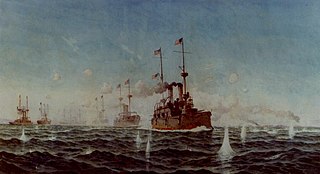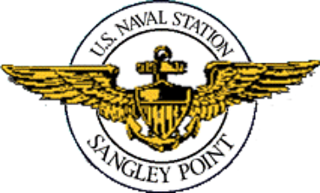
Corregidor is an island located at the entrance of Manila Bay in the southwestern part of Luzon in the Philippines, and is considered part of Cavite City and thus the province of Cavite. It is located 48 kilometres (30 mi) west of Manila, the nation's largest city and one of its most important seaports for centuries since the Spanish colonial period. Due to its strategic location, Corregidor has historically been fortified with coastal artillery batteries to defend the entrance of Manila Bay and Manila itself from attacks by enemy warships.

The Battle of Manila Bay, also known as the Battle of Cavite, took place on 1 May 1898, during the Spanish–American War. The American Asiatic Squadron under Commodore George Dewey engaged and destroyed the Spanish Pacific Squadron under Contraalmirante Patricio Montojo. The battle took place in Manila Bay in the Philippines, and was the first major engagement of the Spanish–American War. The battle was one of the most decisive naval battles in history and marked the end of the Spanish colonial period in Philippine history.

Cavite City, officially the City of Cavite, is a 2nd class component city in the Philippines. According to the 2020 census, it has a population of 100,674 people.

The Philippine Navy (PN) is the naval warfare service branch of the Armed Forces of the Philippines. It has an estimated strength of 24,500 active service personnel, including the 10,300-strong Philippine Marine Corps. It operates 90 combat vessels, 16 auxiliary vessels, 25 manned aircraft and 8 unmanned aerial vehicles. Tracing its roots from the Philippine Revolutionary Navy on May 20, 1898, while its modern foundations were created during the creation of the Offshore Patrol on February 9, 1939, the PN is currently responsible for naval warfare operations and maritime patrol missions within the Philippine Waters, as well as ensuring the protection of the Philippine's maritime interests, including the West Philippine Sea and Benham Rise.

The Naval Special Operations Command (NAVSOCOM) is a separate command of the Philippine Navy trained in special operations, sabotage, psychological and unconventional warfare and is heavily influenced by the United States Navy SEALs. NAVSOCOM is headquartered at Naval Base Heracleo Alano Sangley Point, Cavite City. It has eleven units located across the Philippines, from Naval Operating Base San Vicente at Santa Ana, Cagayan in the north to Naval Station Zamboanga in the south.

Mount Santa Rita was a facility of the United States Navy in Bataan, Philippines. It was the U.S. Naval Link Station (USNAVLINKSTA) within the Philippines. There were approximately 15 people that were permanently attached to this station at any given time, while there were also seven Marine guards who rotated every seven days. These Marine Guards were members of Alpha Company Marine Barracks, Subic Bay. Other than military personnel, there were Philippine nationals that worked there as well.

Naval Station San Miguel is an installation of the Philippine Navy located in Barangay San Miguel, San Antonio, Zambales, Philippines. The United States turned over the base to the Philippine government in 1992. The Philippine's first BrahMos anti-ship missile complex will reportedly be located at the base.
Sangley Point National High School has total land area of 6100 sq.m., and is situated amongst residential units along La Naval Road inside the Naval Station Heracleo Alano in Sangley Point, San Antonio, Cavite City. Located at its back is the historic Cañacao Bay.

The Port of Subic Bay is in the Subic Bay Freeport Zone, the former U.S. Naval Base Subic Bay, on Subic Bay in the Philippines. It is one of the busiest, largest, historical and most important of ports in the Philippines. The Port is operated and managed by the Subic Bay Metropolitan Authority (SBMA).

Cañacao Bay is a small bay located within the larger Manila Bay in Luzon island in the Philippines.

The Cavite Peninsula is a peninsula extending northeast into Manila Bay from the coastal town of Noveleta in Cavite province in the Philippines. The northern tip of the peninsula is geographically the northernmost part of the province of Cavite.

Naval Station Sangley Point was a communication and hospital facility of the United States Navy which occupied the northern portion of the Cavite City peninsula and is surrounded by Manila Bay, approximately eight miles southwest of Manila, the Philippines. The station was a part of the Cavite Navy Yard across the peninsula. The naval station had a runway that was built after World War II, which was used by U.S. Navy Lockheed P-2 Neptune, Lockheed P-3 Orion, and Martin P4M Mercator maritime patrol and anti-submarine warfare aircraft. An adjacent seaplane runway, ramp area and seaplane tender berths also supported Martin P5M Marlin maritime patrol aircraft until that type's retirement from active naval service in the late 1960s. NAS Sangley Point/NAVSTA Sangley Point was also used extensively during the Vietnam War, primarily for U.S. Navy patrol squadrons forward deployed from the United States on six-month rotations. The naval station was turned over to the Philippine government in 1971. It is now operated by the Philippine Air Force and Philippine Navy.

Naval Base Subic Bay was a major ship-repair, supply, and rest and recreation facility of the Spanish Navy and subsequently the United States Navy located in Zambales, Philippines. The base was 262 square miles (680 km2), about the size of Singapore. The Navy Exchange had the largest volume of sales of any exchange in the world, and the Naval Supply Depot handled the largest volume of fuel oil of any navy facility in the world. The naval base was the largest overseas military installation of the United States Armed Forces, after Clark Air Base in Angeles City was closed in 1991. Following its closure in 1992, it was transformed into the Subic Bay Freeport Zone by the Philippine government.

Danilo Atienza Air Base is a military base used by the Philippine Air Force, located on the northern end of the Cavite Peninsula in Manila Bay, Luzon Island, Philippines. It is adjacent to Cavite City, in Cavite Province.

BRP Heracleo Alano (PC-376) is the sixth ship of the Jose Andrada-class coastal patrol boats of the Philippine Navy. It is part of the first batch of its class ordered through U.S. Foreign Military Sales (FMS) in 1990, and was commissioned with the Philippine Navy in January 1992. It was initially designated as Fast Patrol Craft, and was numbered "DF-376", but later on was re-designated as a Patrol Gunboat, and was finally re-numbered as "PG-376". Another round of reclassification was made in April 2016, which redesignated the patrol gunboat as the coastal patrol craft BRP Heracleo Alano (PC-376)
Fort San Felipe is a military fortress in Cavite City, Philippines. It was constructed by the Spanish military in 1609 in the first port town of Cavite, the historic core of the present and larger Cavite City, for its protection. Less than half of the original historic structure survives today. The remaining structure is made of granite blocks with 30-foot high walls and features a wide stairway leading to the top of the bastions and remaining walls. Naval memorabilia including antique cannons and cannonballs decorate the lawns of the fortification. Fort San Felipe is located within the 9-hectare (22-acre) Naval Base Cavite of the Philippine Navy and is not open to the public.

Q-111 Luzon was a motor torpedo boat of the United States Army during World War II as part of the Offshore Patrol based at Manila.

Naval Base Manila, Naval Air Base Manila was a major United States Navy base south of the City of Manila, on Luzon Island in the Philippines. Some of the bases dates back to 1898, the end of the Spanish–American War. Starting in 1938 civilian contractors were used to build new facilities in Manila to prepare for World War II. Work stopped on December 23, 1941, when Manila was declared not defendable against the Empire of Japan southward advance, which took over the city on January 2, 1942, after the US declared it an open city. US Navy construction and repair started in March 1945 with the taking of Manila in the costly Battle of Manila ending on March 2, 1945. Naval Base Manila supported the Pacific War and remained a major US Naval Advance Base until its closure in 1971.

The United States Navy held a number of bases in the Philippines Islands in the Pacific Ocean. Most were built by the US Navy Seabees, Naval Construction Battalions, during World War II. The US Naval Bases in Philippines were lost to the Empire of Japan in December 1941 during the Philippines campaign of 1941–1942. In February 1945 the United States Armed Forces retook the Philippines in the Battle of Manila in 1945. Before the captured US bases on Luzon were retaken the US Navy Seabees built a new large base, Leyte-Samar Naval Base, on the Philippine Island of Leyte, starting in October 1944.

















